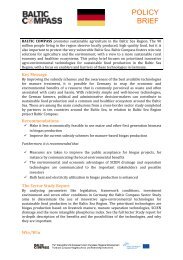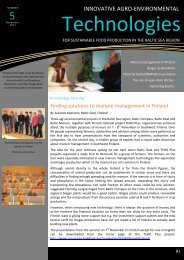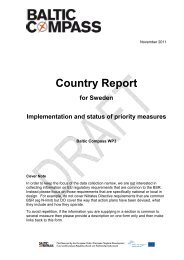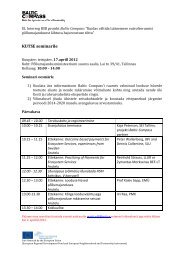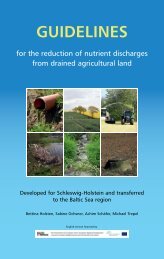A_Greener_2011_Sånga-Säby - Baltic Deal
A_Greener_2011_Sånga-Säby - Baltic Deal
A_Greener_2011_Sånga-Säby - Baltic Deal
Create successful ePaper yourself
Turn your PDF publications into a flip-book with our unique Google optimized e-Paper software.
Conference report: A <strong>Greener</strong> Agriculture for a Bluer <strong>Baltic</strong> Sea, <strong>2011</strong>16Seminar CPart 1 Manure energyThis session was moderated by Markku Järvenpää, from MTT Agrifood Research, Finland,Project manager of <strong>Baltic</strong> Manure.Sari Luostarinen, from MTT Agrifood Research Finland (and leader of <strong>Baltic</strong> ManureWP6) opened the seminar with an Overview of how manure presently is converted into energyin the <strong>Baltic</strong> Sea Region. At present it is almost only biogas that is used, but thermalgasification and incineration can become future technologies to a certain degree. The aims ofthe Work package 6 in <strong>Baltic</strong> manure are threefold:• Calculation of BSR manure energy potential• Show best practices for energy recovery from manure• Develop tools for implementing manure energy recoveryAfter a brief introduction to biogas technologies, the results of a survey on biogasification inthe region were presented. Germany has approximately 6000 biogas plants (mainly farm sizeand based on maize substrate for electricity production), Denmark has approx 100 plants,(many larger, all manure based for CHP), Sweden has some 40 plants (often partly based onorganic solid wastes, used for gas for vehicles). A dozen plants are found in Finland (mostlymanure based), Estonia has one biogas plant using pig manure (38 000 t/a, CHP), Latvia haseight agricultural biogas plants, several under planning / construction. In Lithuania, the onlybiogas plant using pig manure closed down in summer <strong>2011</strong>. Poland has some seven largeragricultural biogas plants, but Government ambitions are to reach 2000 plants before year 2020.It was concluded, that the interest in agricultural biogas, including manure, is rapidly growingin all BSR countries and that• Support mechanisms are being developed• Targets for manure biogas use being set or under consideration• Much of the energy potential in manure is currently not used, and the capacity available issignificantLena Rohde and Andras Baky from JTI – Swedish Institute of Agricultural andEnvironmental Engineering presented a study on Environmentally-friendly handling ofbiogas digestate in agriculture.Anaerobic digestion of manure affects manure positively by:• Higher N-efficiency if handled properly => reduced costs for mineral N• High viscosity – faster infiltration at spreading => less NH 3 -losses, odour• Less stockage, higher evenness at spreading• Greenhouse gases• Make solid manure into liquidDigestion of manure affects the manure positively by:The conference was co-financed by the European Union (European Regional Development Fund and European Neighbouringand Partnerships Instrument) and organised by the project cluster <strong>Baltic</strong> Compass, <strong>Baltic</strong> <strong>Deal</strong> and <strong>Baltic</strong> Manure



